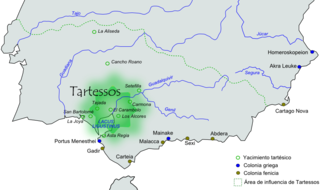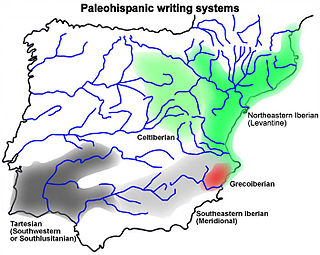
Lusitania or Hispania Lusitana was an ancient Iberian Roman province located where modern Portugal and part of western Spain lie. It was named after the Lusitani or Lusitanian people.
Lusitanian mythology is the mythology of the Lusitanians, the Indo-European people of western Iberia, in the territory comprising most of modern Portugal, Galicia, Extremadura and a small part of Salamanca.

The Lusitanians were an Indo-European people living in the west of the Iberian Peninsula prior to its conquest by the Roman Republic and the subsequent incorporation of the territory into the Roman province of Lusitania.
Lusitanic is a term used to refer to persons who share the linguistic and cultural traditions of the Portuguese-speaking nations, territories, and populations, including Portugal, Brazil, Macau, Timor-Leste, Angola, Mozambique, Cape Verde, São Tomé and Príncipe, Guinea Bissau and others, as well as the Portuguese diaspora generally.

Lusitanian was an Indo-European Paleohispanic language. There has been support for either a connection with the ancient Italic languages or Celtic languages. It is known from only five sizeable inscriptions, dated from circa 1 CE, and numerous names of places (toponyms) and of gods (theonyms). The language was spoken in the territory inhabited by Lusitanian tribes, from the Douro to the Tagus rivers, territory that nowadays falls in central Portugal and western Spain.

The Cynetes or Conii were one of the pre-Roman peoples of the Iberian Peninsula, living in today's Algarve and Lower Alentejo regions of southern Portugal, and the southern part of Badajoz and the northwestern portions of Córdoba and Ciudad Real provinces in Spain before the 6th century BCE.

The Celtici were a Celtic tribe or group of tribes of the Iberian peninsula, inhabiting three definite areas: in what today are the regions of Alentejo and the Algarve in Portugal; in the Province of Badajoz and north of Province of Huelva in Spain, in the ancient Baeturia; and along the coastal areas of Galicia. Classical authors give various accounts of the Celtici's relationships with the Gallaeci, Celtiberians and Turdetani.

Hispano-Celtic is a hypernym to include all the varieties of Celtic spoken in the Iberian Peninsula before the arrival of the Romans :

The Tartessian language is the extinct Paleohispanic language of inscriptions in the Southwestern script found in the southwest of the Iberian Peninsula: mainly in the south of Portugal, and the southwest of Spain. There are 95 of these inscriptions, the longest having 82 readable signs. Around one-third of them were found in Early Iron Age necropolises or other Iron Age burial sites associated with rich complex burials. It is usual to date them to the 7th century BC and consider the southwestern script to be the most ancient Paleohispanic script, with characters most closely resembling specific Phoenician letter forms found in inscriptions dated to c. 825 BC. Five of the inscriptions occur on stelae with what has been interpreted as Late Bronze Age carved warrior gear from the Urnfield culture.

Castro culture is the archaeological term for the material culture of the north-western regions of the Iberian Peninsula from the end of the Bronze Age until it was subsumed by Roman culture. It is the culture associated with the Celtiberians, closely associated to the western Hallstatt horizon of Central Europe.

The Southwest Script or Southwestern Script, also known as Tartessian or South Lusitanian, is a Paleohispanic script used to write an unknown language usually identified as Tartessian. Southwest inscriptions have been found mainly in the southwestern quadrant of the Iberian Peninsula, mostly in the south of Portugal, but also in Spain.

The Paleohispanic languages were the languages of the Pre-Roman peoples of the Iberian Peninsula, excluding languages of foreign colonies, such as Greek in Emporion and Phoenician in Qart Hadast. After the Roman conquest of Hispania the Paleohispanic languages, with the exception of Proto-Basque, were replaced by Latin, the ancestor of the modern Iberian Romance languages.
Reo is a name appearing on Latin dedications to a Lusitanian-Gallaecian deity, usually with an epithet relating to a place, such as Reo Paramaeco discovered in Lugo in Galicia. The name Reo is in the Latin dative case, for a Latinized name *Reus.

The Bardili were a small, pre-Roman people of the Iberian peninsula, and an off-shot of the widespread Turduli people, who lived in what is now southwestern Portugal in the 5th-1st centuries BC.
Gallaecian, or Northwestern Hispano-Celtic, is an extinct Celtic language and was one of the Hispano-Celtic languages. It was spoken at the beginning of the 1st millennium in the northwest corner of the Iberian Peninsula that became the Roman province of Gallaecia and is now divided between the modern regions of Galicia, Norte Region, Portugal, western Asturias, and the Province of León, in Spain.
The Nerii were an ancient Gallaecian Celtic tribe, living in the north of modern Galicia, in the Costa da Morte region. Celtici Nerii are mentioned for the first time on a tombstone on the grave of a Galician nerio called Tássionos, in a Tartessian inscription from the Bronze Age.
Punicus was a chieftain of the Lusitanians, a Celtic tribe from western Hispania. He became their first military leader during the Lusitanian War, and also led their first major victories against Rome.














